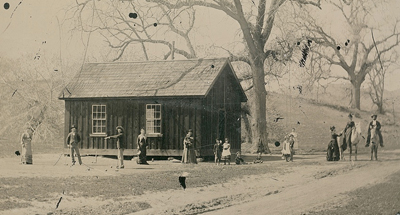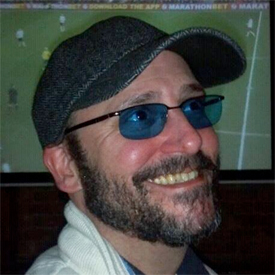James Steelman ’96 Brings New Evidence on Billy the Kid to Your Living Room

If you saw the National Geographic program BIlly the Kid: New Evidence on Oct. 18th, you heard the remarkable story of a collector who bought an old photo for $2 in a junk shop in California in 2010. Experts now believe that the find is only the second authenticated photo of famed outlaw Billy the Kid, and it’s worth millions. And if you saw the show, you also saw the work of Film major James Steelman ’96, editor at Leftfield Entertainment in New York City, which produced the show.
“The show is an example of parallel storytelling,” Steelman explained. “We told the modern story of Randy Guijarro (who found the tintype and sought to have it authenticated) as well as the historical story of Billy the Kid. I was originally brought on to handle the historical recreations, but as we got deeper into the revision process, I also contributed to the modern story, and assisted in the assembly and polishing of acts (the content between commercials).” The story of the search to have the photo authenticated continued as Steelman edited, making it a real challenge to meet the Oct. 18th air date. “I’m very proud of the work I did on it and feel that it’s the best work I’ve done so far,” Steelman said.

“I was very fortunate to have been chosen from over 100 editors at Leftfield to be one of only two editors on Billy the Kid: New Evidence,” Steelman said. “Editors on television shows are multimedia content editors, so in addition to editing picture and dialogue, I also chose the music for the segments I cut, and added sound effects where necessary (such as in the gunfights). It’s a process involving many revisions, as my work is subject to the scrutiny of Leftfield’s executive producers, as well as the network executives at National Geographic. They give feedback on the work in progress, and we make the revisions as requested. It’s a collaborative process, and, in this case, the revision process was extensive.”
Steelman cited the value of his Keene State education, especially the critical studies classes he took with Dr. Larry Benaquist and an editing class with Paul Barnes, who went on to work with Ken Burns on such remarkable documentaries as Jazz, Baseball, and The Civil War. But at that time, the Film Studies Dept. was still working in film, as opposed to today’s digital video. In 2000, Steelman went to work for Avid Technology in Tewksbury, MA, where he was trained to use their suite of non-linear editing systems, commonly known as Avid Media Composer. “I returned to KSC in 2002 and worked with Dr. Benaquist and Professor Tom Cook to modernize the program, adding non-linear editing to the curriculum. I stayed there for six years, and I am very pleased to say that many of my editing students are currently enjoying careers in film and television editing.”
If you missed the National Georaphic show, here’s a clip.





